

Thomas Geissmann's Gibbon Research Lab. and the Gibbon Network. Cercopithecinae. The Cercopithecinae are a subfamily of the Old World monkeys, that includes in its roughly 71 species the baboons, the macaques and the vervet monkeys.
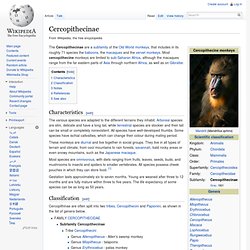
Most cercopithecine monkeys are limited to sub-Saharan Africa, although the macaques range from the far eastern parts of Asia through northern Africa, as well as on Gibraltar. Characteristics[edit] The various species are adapted to the different terrains they inhabit. Arboreal species are slim, delicate and have a long tail, while terrestrial species are stockier and their tail can be small or completely nonexistent. All species have well-developed thumbs. These monkeys are diurnal and live together in social groups. Most species are omnivorous, with diets ranging from fruits, leaves, seeds, buds, and mushrooms to insects and spiders to smaller vertebrates. Gestation lasts approximately six to seven months. Classification[edit] Notes[edit] Jump up ^ Strier, Karen B. (2007). References[edit] Groves, C. See also[edit] Parapapio.
Platyrrhines. Catarrhini. Catarrhini is one of the two subdivisions of the higher primates (the other being the New World monkeys or platyrrhines).
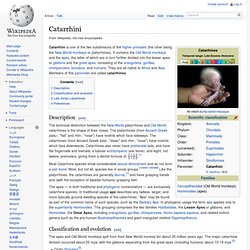
It contains the Old World monkeys and the apes; the latter of which are in turn further divided into the lesser apes or gibbons and the great apes, consisting of the orangutans, gorillas, chimpanzees, bonobos, and humans. They are all native to Africa and Asia. Members of this parvorder are called catarrhines. Description[edit] The technical distinction between the New World platyrrhines and Old World catarrhines is the shape of their noses. Most Catarrhine species show considerable sexual dimorphism and do not form a pair bond. The apes — in both traditional and phylogenic nomenclature — are exclusively catarrhine species. Classification and evolution[edit] The apes and Old World monkeys split from their New World monkey kin about 35 million years ago. Late Asian catarrhines[edit] In May 2005, three new primate fossils were discovered in the Bugti Hills of Pakistan.
Monkey. A monkey is any nonhuman primate, with the usual exception of the lemurs and tarsiers.[1] Thus defined, there are three type of monkeys: (1) non-human hominoids (also known as apes), (2) old world monkeys, and (3) new world monkeys.
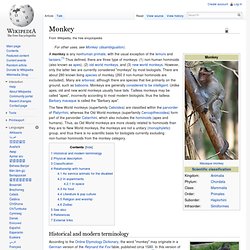
However, only the latter two are currently considered "monkeys" by most biologists. There are about 280 known living species of monkey (260 if non-human hominoids are excluded). CHCI. Simian. The simians (infraorder Simiiformes, Anthropoidea) are the "higher primates" familiar to most people: the Old World monkeys and apes, including humans, (together being the catarrhines), and the New World monkeys or platyrrhines.
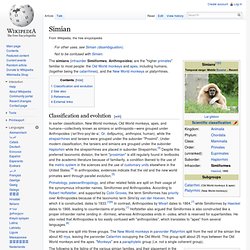
Classification and evolution[edit] In earlier classification, New World monkeys, Old World monkeys, apes, and humans—collectively known as simians or anthropoids—were grouped under Anthropoidea (/an'thro-poy'de-a/, Gr. άνθρωπος, anthropos, human), while the strepsirrhines and tarsiers were grouped under the suborder "Prosimii". Primatology, paleoanthropology, and other related fields are split on their usage of the synonymous infraorder names, Simiiformes and Anthropoidea. The simians are split into three groups. The New World monkeys in parvorder Platyrrhini split from the rest of the simian line about 40 mya, leaving the parvorder Catarrhini occupying the Old World. See also[edit] Simia, Carolus Linnaeus's original classification of these primates.
Living Primates. Gibbon Conservation Center. Primate Photo Gallery: chimpanzees, gorillas, orang-utans, monkeys, lemurs. Primates - humans, examples, body, animals, part, Lower primates, Higher primates, Bridging the gap between lower and higher primates. Photo by: Kitch Bain The mammals (warm-blooded animals) called primates include the lower primates (lemurs, lorises, and tarsiers) and the higher primates (monkeys, apes, and humans).
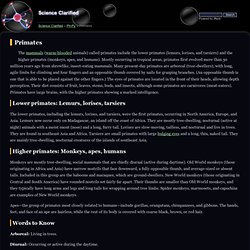
Mostly occurring in tropical areas, primates first evolved more than 50 million years ago from shrewlike, insect-eating mammals. Many present-day primates are arboreal (tree-dwellers), with long, agile limbs for climbing and four fingers and an opposable thumb covered by nails for grasping branches. (An opposable thumb is one that is able to be placed against the other fingers.) Ape. Apes (Hominoidea) are a branch of Old World tailless anthropoid catarrhine primates native to Africa and Southeast Asia and distinguished by a wide degree of freedom at the shoulder joint indicating the influence of brachiation.
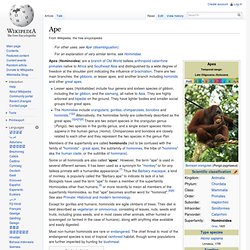
Fleagle (1998) Taxonomy of the Primates.